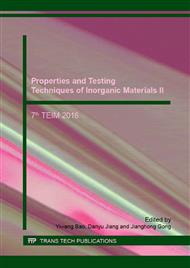[1]
CZ Li, YD Li and NQ Feng, Development and properties of polycarbosylic type high performance water-reducer, J. China Concrete and Cement Products. 2 (2002) 3-6.
Google Scholar
[2]
A Jumadurdiyev, MH Ozkul, AR Saglam and N Parlak, The utilization of beet molasses as a retarding and water- reducing admixture for concrete, J. Cement and Concrete Research. 5 (2005) 874-882.
DOI: 10.1016/j.cemconres.2004.04.036
Google Scholar
[3]
T Kavas, A Olgun and Y Erdogan, Setting and hardening of borogypsum-Portland cement clinker-fly ash blends. Studies on effects of molasses on properties of mortar containing borogypsum, J. Cement and Concrete Research. 4 (2005) 711-718.
DOI: 10.1016/j.cemconres.2004.05.019
Google Scholar
[4]
X Liu, Z Wang, J Zhu, et al, Synthesis, characterization and performance of a polycarboxylate superplasticizer with amide structure, J. Colloids and Surfaces A: Physicochemical and Engineering Aspects. 448 (2014) 119-129.
DOI: 10.1016/j.colsurfa.2014.02.022
Google Scholar
[5]
GS Liao, H Pan and Y Xiao, Research on synthesis and performances of control-released polycarboxylic water reducer, J. New Building Materials. 4 (2013) 54-58.
Google Scholar
[6]
H Wang, JJ Pang, RR Ye, et al, Theoretical research on room temperature synthesis process of polycarboxylate superplasticizer, J. Ready-mixed Concrete. 5 (2014) 27-29.
Google Scholar
[7]
ZY Duan, X Huang, T Wang, et al, Development research on control-released polycarboxylic water reducer synthesized at room temperature, J. Guangdong Building Materials. 8 (2015) 23-26.
Google Scholar
[8]
XL Chen, Synthesis and performance research of polycarboxylate superplasticizer at normal temperature, J. New Building Materials. 12 (2014) 80-83.
Google Scholar
[9]
LZ Zhu, XJ Fu, ZY Xia, et al, Study on synthesis of polycarboxylic acid water-reducing agent under normal atmospheric temperature, J. Concrete. 7 (2013) 59-61.
Google Scholar
[10]
MQ Guan, The conventional temperature synthesis of high performance polycarboxylates superplasticizer by the oxidation-reduction composite system, J. New Building Materials. 8 (2014) 64-67.
Google Scholar
[11]
JY Jiang, GQ Gai, LW Kong, et al, Research progress of compatibility between raw materials composed of concrete and polycarboxylate superplasticizers, J. Concrete. 11 (2015) 69-74.
Google Scholar
[12]
CZ Li, JC Liu, Q Wang, et al, Influence of acid/ether-ratio on composition and dispersive property of polycarboxylic type water reducers, J. New Building Materials. 12 (2013) 80-83, 87.
DOI: 10.4028/www.scientific.net/amr.1119.245
Google Scholar


